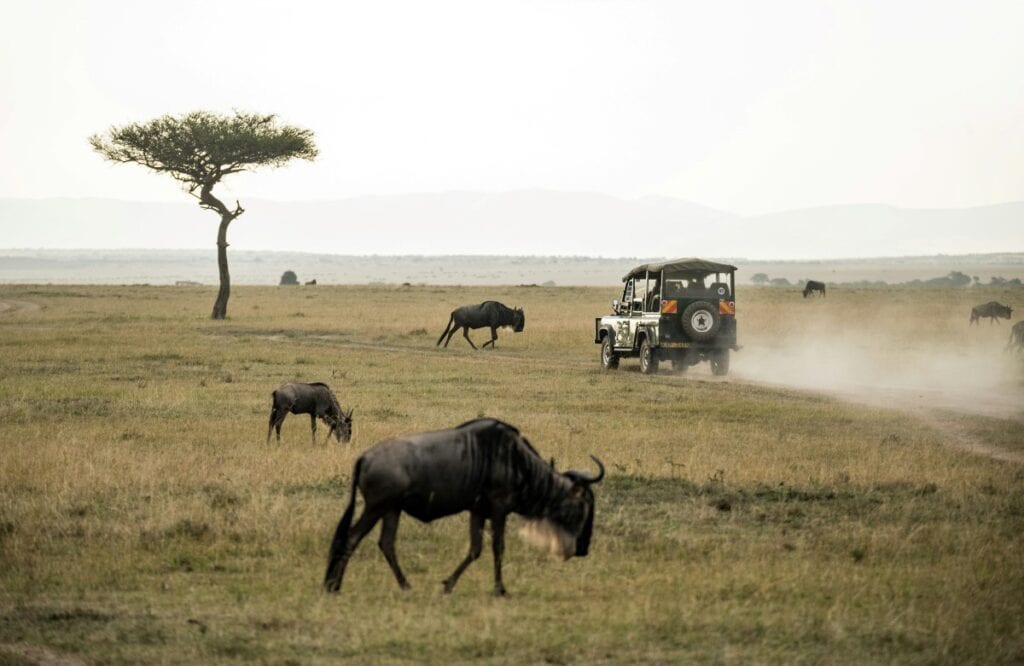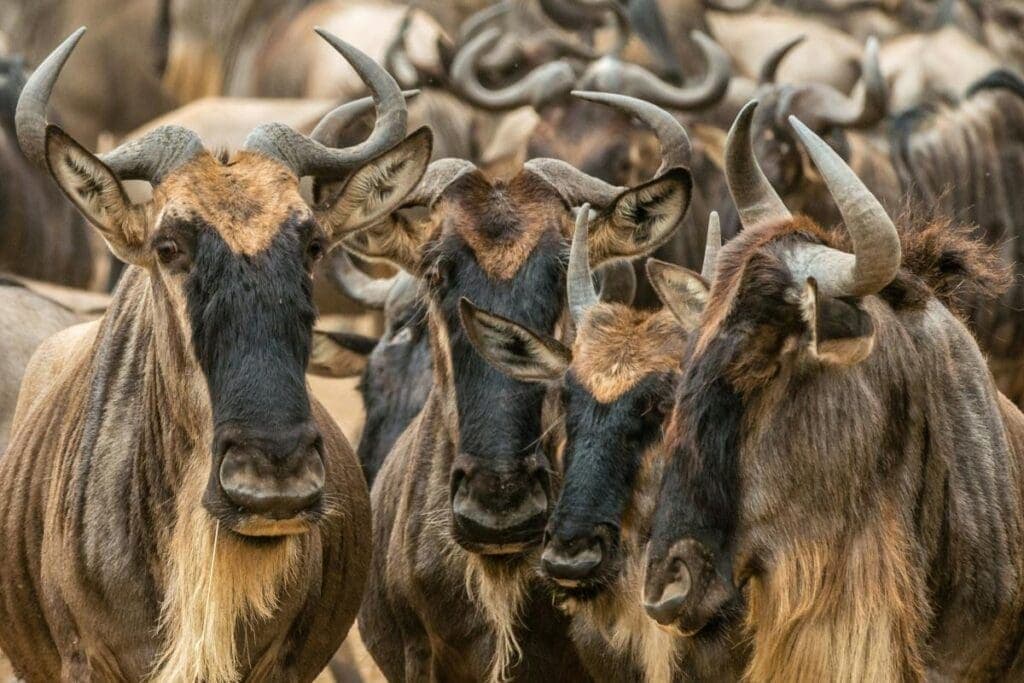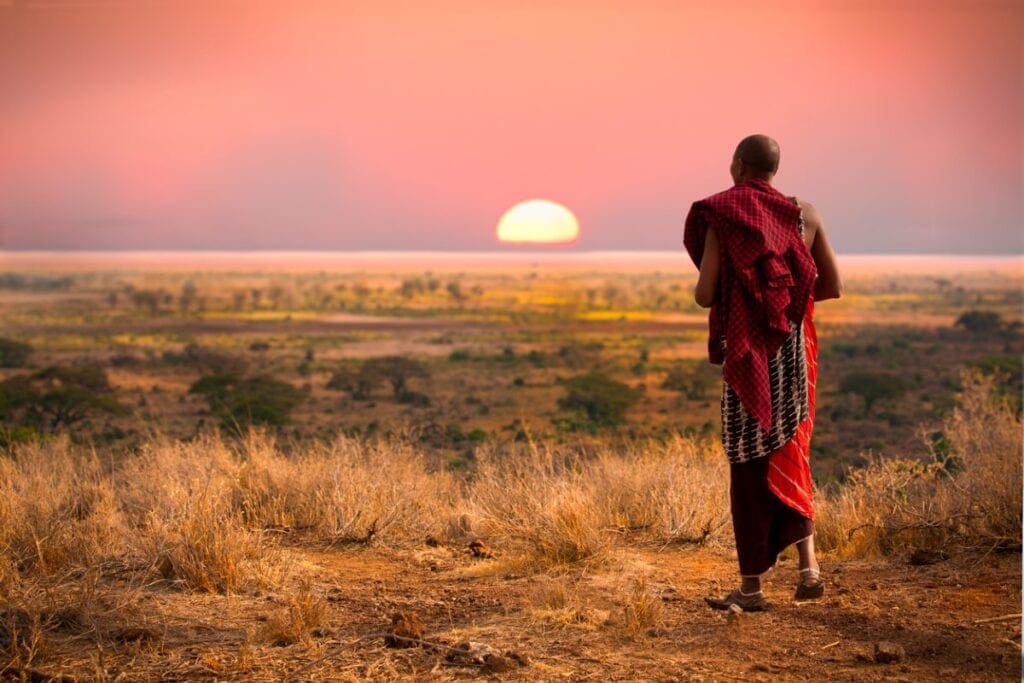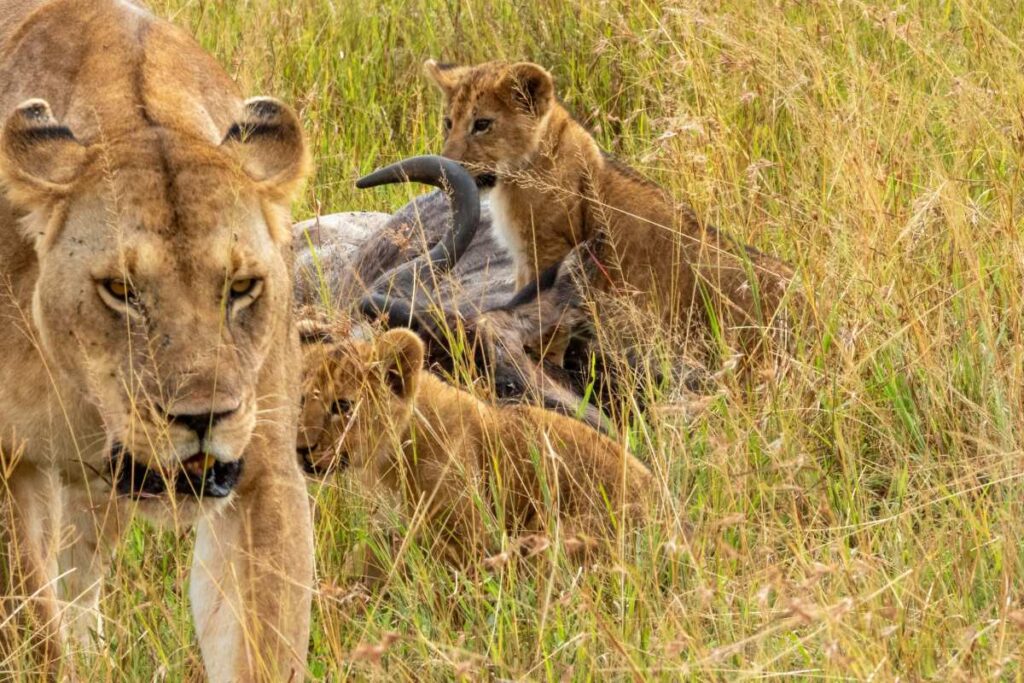HerdTracker is a collaborative tool that helps travellers, guides, rangers, and others to track the annual Great Migration in Tanzania and Kenya. Each year, thousands of people visit several key locations to witness it up close, eager to see one of the genuine wonders of the natural world.
The migration starts in the Ngorongoro Conservation Area in southern Tanzania. More than 2 million wildebeest join vast numbers of other game and migrate in a massive loop, seeking out fresh, green grass. After the herds pass through the Serengeti, they end up in the Maasai Mara in southwestern Kenya, and the cycle begins anew.
As we celebrate 10 years of HerdTracker, launched in April 2014, we’re showcasing the raw power of the Great Migration and the kind of moments that make this one of the greatest events in the animal kingdom.
We spoke to several safari guides and rangers to hear their most memorable sightings – and to understand how these conservation areas continue to evolve in the face of desperate challenges.
Let’s explore these stories from the ground.
Safari Guides Share Their Best Great Migration Sightings

For most people, seeing the Great Migration is a once-in-a-lifetime opportunity. However, for many safari guides and park rangers, it’s simply daily life. So, who better to share their best sightings?
Mohamed Hassan is a professional safari guide and photographer based in Arusha, Tanzania. He says that his unforgettable scene took place during the Covid-19 pandemic, when tourism was virtually non-existent in the region.
“I was lucky to have a few safaris during Covid,” he says. “One of them was during a river crossing – it was my first huge wildebeest crossing and lasted 10 hours.”
He says it might have been even longer. However, what made it truly special was the fact that his was the only vehicle on the scene.
Manja Kema, a field and walking guide in the Serengeti National Park, also enjoyed his best sighting at a river crossing. However, this Mara River story involved predators.
“We were waiting for the first crossing of the season for three hours,” he says. “One lion was on the other side and started catching one wildebeest after another.”
In the end, he says, the lion caught seven wildebeest, but two escaped.
“Two of them survived this due to the greedy lion not making sure that they were killed before going to another one,” he adds.
View this post on Instagram
It’s not the only near-miss Kema has witnessed, either. On several occasions, he’s watched desperate wildebeest mothers defend their calves against lions and cheetahs.
Kingson Mazee, a Tanzanian professional wildlife photographer, has also experienced this up close.
“The best sighting was when I saw a wildebeest giving birth surrounded by a lot of predators,” he explains. “But that mother was able to protect the calf and the calf was alive.”
But nature can be ruthless, too. Manja says that sometimes, lost wildebeest calves will follow lions, desperate to nurse. The lions, of course, have other ideas.
HerdTracker in Action

Kingson, Mohamed, and Manja all say that they use HerdTracker to predict the movement of the Great Migration.
“I have used HerdTracker many times, specifically during the crossing time to know if the herds are in the northern Serengeti or not,” says Kingson.
View this post on Instagram
Mohamed says he first learned about HerdTracker a year before the Covid-19 pandemic.
“I have experienced that guests who are coming for migrations use HerdTracker to actually know where to book and plan their perfect safari,” he adds. “Tour operators, as well – they know exactly where to get information.”
He explains that guides, rangers, and other conservation professionals need good scientific data on where, when, and why migrations occur “to inform conservation and management decisions”.
“This includes mapping the movements and ranges of wildebeest, the ecological drivers of migration, population levels, and a good understanding of the threats to migrants and their habitats,” he says.
An Ecosystem Under Threat

Mohamed says that over the past 10 years, changes in weather patterns have had a visible effect on the Great Migration, especially for the animals that depend on seasonal rains. Kingson agrees, saying that in recent seasons, erratic rains have caused disruptions.
“The wildebeest migration has changed a lot these [past] two years,” he says. “The [herds] arrived very early in central Serengeti, which was having a lot of rain compared to the Ndutu side. Because of heavy rains in the south, they went back.”
View this post on Instagram
Aside from climate change, these ecosystems also face human-made threats like poaching and habitat destruction.
“In the past, protected areas were able to sustain large migratory wildebeest populations because human population densities were low enough to allow them to migrate outside of protected areas to their wet season ranges,” Mohamed says.
He adds that as habitat loss intensifies, large wildlife populations become more and more consolidated, disrupting the Great Migration.
“Today, nearly all the world’s remaining large wildlife populations exist in unfragmented migratory systems,” he explains. “For example, the Ngorongoro / Serengeti-Mara ecosystem migration has been sustained because it has survived in a relatively intact ecosystem contained within a network of protected areas that encompass all the grazing habitats required to support a large migratory population.”
Ensuring the Future of the Great Migration

So, how can we protect the longevity of one of Earth’s greatest natural phenomena? Kingson believes that it starts at ground level. Whether it’s poaching or habitat destruction, humans must find harmony with East Africa’s precious ecosystems.
“Ordinary people can conserve the migration by not putting fences along the migration routes, specifically in the villages near to the park on the way to northern Serengeti,” he says. “Also, by discouraging snare poaching.”
View this post on Instagram
Thankfully, Manja says poaching is definitely decreasing, largely thanks to education and tourism initiatives.
“We used to see a lot of animals [caught in] snares, like giraffes, wildebeest, and zebras,” he says. “Even today, you still see it, but very little compared to some years back.”
Kingson agrees, noting that locals who engage in tourism-related activities are less likely to take part in poaching. However, Mohamed emphasises that there’s still work to be done to prevent further human-wildlife conflict.
“Urgent efforts need to be made to protect wildebeest migratory corridors and dispersal areas to ensure these Great Migrations for the future,” adds Mohamed. “Wildebeest migrations are important both ecologically and economically. They also have a direct effect on predator populations and other wildlife species – and on grass food resources.”

Thanks to the work of people like Mohamed, Kingson, and Manja, HerdTracker has allowed over 10.6 million users to experience the incredible phenomenon of the Great Migration over the last decade– whether from their couch or the front-row seat of an open safari vehicle. Be part of the HerdTracker mission: share your migration sightings to our online platform and help us inspire the next generation of safari travellers.
Author: Vihann Van Wyk
Published:
Part of the East Africa Safari Collection